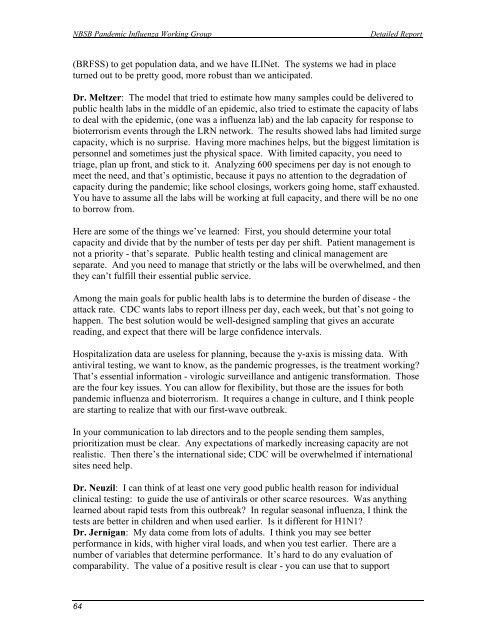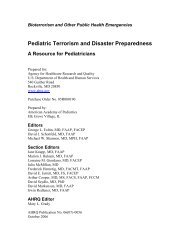H1N1 COUNTERMEASURES STRATEGY AND ... - PHE Home
H1N1 COUNTERMEASURES STRATEGY AND ... - PHE Home
H1N1 COUNTERMEASURES STRATEGY AND ... - PHE Home
Create successful ePaper yourself
Turn your PDF publications into a flip-book with our unique Google optimized e-Paper software.
NBSB Pandemic Influenza Working Group<br />
Detailed Report<br />
(BRFSS) to get population data, and we have ILINet. The systems we had in place<br />
turned out to be pretty good, more robust than we anticipated.<br />
Dr. Meltzer: The model that tried to estimate how many samples could be delivered to<br />
public health labs in the middle of an epidemic, also tried to estimate the capacity of labs<br />
to deal with the epidemic, (one was a influenza lab) and the lab capacity for response to<br />
bioterrorism events through the LRN network. The results showed labs had limited surge<br />
capacity, which is no surprise. Having more machines helps, but the biggest limitation is<br />
personnel and sometimes just the physical space. With limited capacity, you need to<br />
triage, plan up front, and stick to it. Analyzing 600 specimens per day is not enough to<br />
meet the need, and that’s optimistic, because it pays no attention to the degradation of<br />
capacity during the pandemic; like school closings, workers going home, staff exhausted.<br />
You have to assume all the labs will be working at full capacity, and there will be no one<br />
to borrow from.<br />
Here are some of the things we’ve learned: First, you should determine your total<br />
capacity and divide that by the number of tests per day per shift. Patient management is<br />
not a priority - that’s separate. Public health testing and clinical management are<br />
separate. And you need to manage that strictly or the labs will be overwhelmed, and then<br />
they can’t fulfill their essential public service.<br />
Among the main goals for public health labs is to determine the burden of disease - the<br />
attack rate. CDC wants labs to report illness per day, each week, but that’s not going to<br />
happen. The best solution would be well-designed sampling that gives an accurate<br />
reading, and expect that there will be large confidence intervals.<br />
Hospitalization data are useless for planning, because the y-axis is missing data. With<br />
antiviral testing, we want to know, as the pandemic progresses, is the treatment working?<br />
That’s essential information - virologic surveillance and antigenic transformation. Those<br />
are the four key issues. You can allow for flexibility, but those are the issues for both<br />
pandemic influenza and bioterrorism. It requires a change in culture, and I think people<br />
are starting to realize that with our first-wave outbreak.<br />
In your communication to lab directors and to the people sending them samples,<br />
prioritization must be clear. Any expectations of markedly increasing capacity are not<br />
realistic. Then there’s the international side; CDC will be overwhelmed if international<br />
sites need help.<br />
Dr. Neuzil: I can think of at least one very good public health reason for individual<br />
clinical testing: to guide the use of antivirals or other scarce resources. Was anything<br />
learned about rapid tests from this outbreak? In regular seasonal influenza, I think the<br />
tests are better in children and when used earlier. Is it different for <strong>H1N1</strong>?<br />
Dr. Jernigan: My data come from lots of adults. I think you may see better<br />
performance in kids, with higher viral loads, and when you test earlier. There are a<br />
number of variables that determine performance. It’s hard to do any evaluation of<br />
comparability. The value of a positive result is clear - you can use that to support<br />
64
















